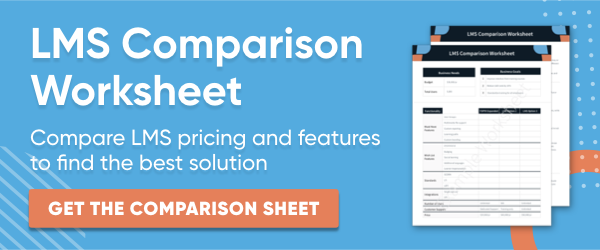Selecting the correct online learning software for your business is a complicated endeavor. In a global market that is expected to grow from 9.8 billion to 22.4 billion in the next five years¹, there are more than 700 different eLearning and learning management system vendors in business². Each vendor offers a unique suite of features, content, and pricing options.
Which LMS is right for your business will hinge on a variety of factors. To find the best system to meet your needs, we recommend collecting an LMS overview from all your options, doing an LMS features comparison, and evaluating how well each platform connects to your business goals.
Through each of those elements, however, you’ll find a common theme: LMS systems are built for vastly different audiences. Some online learning software is ideal for universities educating thousands of students, while others are built for companies educating hundreds or thousands of employees. In the business market, in particular, you’ll see further segmentation based on business size.
Business size is a major factor that affects how well an enterprise LMS will serve your company because vendors design and update systems differently based on who will be using them. In this article, we’ll take an in-depth look at how your business size impacts the LMS system you need, as well as what small, medium, and large businesses should look for in a new platform.

Why Does Business Size Matter?
When it comes to an LMS, the biggest impact of business size is the number of learners who will be using the platform and how complex training will be. Smaller companies (less than 300 employees) have fewer end users and often have simpler training needs than both mid-sized companies (300 – 1000 employees) and large enterprises of over 1000 employees. Those differences break down into vastly different LMS requirements for each business size.
Small Companies (Less than 300 Employees)
Small companies typically have fewer employees who need to use the LMS system for training. They often have a more limited number of learning paths, courses, and ongoing training requirements, making it easier for small companies to use LMS systems with fewer features, that come at a lower cost.
Small companies may also need to place more emphasis on costs than they do on getting a full range of LMS features, because they’re often working on a smaller budget than large enterprises. There are many free, or low-cost solutions that may be effective for a small business. Often they charge a per-learner fee, which is easily estimated and budgeted in a smaller company. They can also be scalable, providing a company the opportunity to continue training during a period of rapid growth.
Support is also important in a smaller company, where employees tend to have a wide variety of different duties and responsibilities, and less time to devote to managing a single application.
A low-cost LMS generally provides an intuitive, easy-to-master interface that is very appealing for a smaller company; however, mobile access, customizations and integrations with other business systems may not be available as they are in full-featured enterprise LMS platforms.
A free (open source), or low-cost LMS is a good choice for a small company to standardize training, such as new hire onboarding, for an effective and efficient employee training solution.
Mid-Sized Companies (300-1000 Employees)
Mid-sized companies may have more in-depth requirements for an LMS than startups. They typically have more developed infrastructure, making technology integrations of greater concern. The ability to customize content will be more important, as well as the ability to create customized reports for different stakeholders throughout the organization.
Mid-sized companies are also more likely to be training a larger number of employees with a higher degree of complexity, creating tailored content for different job positions. Those employees and job positions may be spread out across multiple offices or locations, making it essential for companies to have the ability to deliver standardized training to multiple locations at the same time.
Instead of a free or low-cost-per-user solution, a mid-sized company should look for a more mature LMS that includes sophisticated content hosting (think multimedia support and customized learning paths that you can use for different job positions), business systems integrations, and options for adding or customizing content.
Large Companies (Over 1000 Employees)
Nearly all large enterprises use online learning software for at least part of their employee training. It’s essential because large enterprises have employees spread out across the country or around the world, some working from central headquarters, regional satellite offices, or from home. Online learning makes it easier for all employees, regardless of location or job function, to receive effective training. It also provides cost savings, flexibility, and streamlined administration for the business.
To meet the needs of a large employee base, large enterprises need an LMS that offers a distributed learning environment with diverse content that can be used by employees in different departments.
Because a large company is more complex, integrations such as single sign-on (SSO), and features like social and video learning, mobile access and BYOD, and compliance tracking may be essential.
An LMS for a large corporation should include extensive customization of both interface and content, to allow for engaging, contextual, specific learning for each job function and career path. In-depth LMS reporting capabilities ensure that stakeholders throughout the organization have required information to support strategic learning goals and meet compliance requirements.
Infrastructure is more complex at a large organization, and an LMS that can be integrated with other business systems may provide valuable data and insights that can be used throughout the business. API, custom APIs, SSO, FTP and Salesforce integrations can link eLearning to outcomes, providing another measure of effectiveness for the LMS.
Finally, a large company will also have something in common with smaller businesses - a need for a cost-effective solution. With a large employee base to train, per-user fees can quickly become unsustainable, eating up your L&D budget. As such, many enterprises look for online learning software that offers flat rates based on user caps, not per user fees. The best online learning software, for instance, will offer pricing tiers, with the highest tier supporting unlimited users for a flat fee.
Business Size Influences LMS Needs through User Numbers, Feature Needs, and Integration Requirements
As businesses grow, their training needs grow with them, becoming more complex as employees, job roles, and locations are added. Choosing the right LMS should take all these factors into account, along with business goals. Small businesses may set goals to reduce administration by hosting all content in a single location. Big businesses may focus more on ROI by reducing employee training costs, administrative needs, and upskilling their workforce in specific job functions to gain a competitive advantage.
Reviewing your business size and its needs is a good place to start your search for an eLearning platform. Follow up with more detailed LMS overviews and features comparisons to get a complete picture of each option.
Resources:
1 https://www.marketsandmarkets.com/Market-Reports/learning-management-systems-market-1266.html
2 https://talentedlearning.com/why-so-many-lms-vendors/






